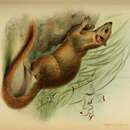en
names in breadcrumbs


Perception Channels: tactile ; chemical
IUCN Red List of Threatened Species: least concern
None known
Prior to being classified in their own order, Scandentia, tree shrews were placed either in the Order Insectivora or in the Order Primates. Considered primitive primates, they were popular experimental subjects in neurobiology and neuroanatomy. Tree shrews were "considered ideal subjects to gain insight into the organization of the early primate visual system" (German Primate Center). Anathana ellioti, rare in the wild and in captivity, is of no economic importance to humans (Chorazyna and Kurup 1975).
Positive Impacts: research and education
Indian tree shrews are omnivorous. They eat insects such as caterpillars, flying ants, and butterflies as well as earthworms and fruit (such as wild berries). They have also been observed eating the fruit of Lantana camara, a common thorny shrub. Anathana ellioti only occasionally uses its hands when eating insects and fruit. Indian tree shrews spend much of their morning and evening hours foraging for food. Foraging is always solitary (Chorazyna and Kurup 1975).
Animal Foods: insects; terrestrial worms
Plant Foods: fruit
Primary Diet: omnivore
Indian or Madras tree shrews are found on the Indian subcontinent south of the Ganges River (Roonwal and Mohnot 1977). Three subspecies are recognized according to their specific geographic range. Anathana ellioti ellioti inhabits the Eastern Ghats and the Shevaroy Hills of Southern India (Waterhouse 1850 in Roonwal and Mohnot 1977). Anathana ellioti pallida is found in Central India primarily in Madhya Pradesh and Raipur northwest of the Ganges River (Lyon 1913 in Roonwal and Mohnot 1977), and Anathana ellioti wroughtoni lives in Western India in the Satpura Range and the Dangs near Bombay (Lyon 1913 in Roonwal and Mohnot 1977).
Biogeographic Regions: oriental (Native )
Indian tree shrews have been sighted in moist to semi-moist deciduous forests in an overall dry deciduous area (Shrivastava 1994). They have also been observed on stone covered slopes and ravines, some near cultivated fields and pastures (Chorazyna and Kurup 1975; Shrivastava 1994).
Habitat Regions: tropical
Terrestrial Biomes: forest
Anathana ellioti resembles Tupaia in appearance but has larger ears with thicker hair than does Tupaia. Indian tree shrews' upper parts are speckled with brown, yellow, and black often with a reddish tinge (Nowak 1997). The ventral portion is nearly white as is an oblique shoulder stripe (Roonwal and Mohnot 1977). Body and head length range from 16.0cm to 18.5cm and tail length ranges from 16.5cm to 19.5cm. The dilambdodont dentition of A. ellioti reflects its omnivorous feeding habits. The dental formula is 2/3 1/1 3/3 3/3 = 9/10 (Verma 1965).
Average mass: 160 g.
Other Physical Features: endothermic ; bilateral symmetry
Not primarily arboreal mammals, Indian tree shrews have been known to climb trees rapidly when alarmed or frightened (Chorazyna and Kurup 1975; Shrivastava 1995). This is likely an adaptation to escape predation.
Little is known of the reproductive behavior of A. ellioti. According to the anatomy of its reproductive system, five young may be produced at a time (Verma 1965). In contrast to Tupaia in which the male testes are scrotal, the testes are abdominal in A. ellioti (Verma 1965; Hayssen 1993).
Range number of offspring: 1 to 5.
Key Reproductive Features: gonochoric/gonochoristic/dioecious (sexes separate); sexual ; fertilization (Internal ); viviparous